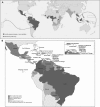Overview of Zika virus (ZIKV) infection in regards to the Brazilian epidemic
- PMID: 27143174
- PMCID: PMC4855997
- DOI: 10.1590/1414-431X20165420
Overview of Zika virus (ZIKV) infection in regards to the Brazilian epidemic
Abstract
Zika virus (ZIKV), a mosquito-borne flavivirus, belongs to the Flaviviridae family, genus Flavivirus. ZIKV was initially isolated in 1947 from a sentinel monkey in the Zika forest, Uganda. Little clinical importance was attributed to ZIKV, once only few symptomatic cases were reported in some African and Southeast Asiatic countries. This situation changed in 2007, when a large outbreak was registered on the Yap Island, Micronesia, caused by the Asian ZIKV lineage. Between 2013 and 2014, ZIKV spread explosively and caused many outbreaks in different islands of the Southern Pacific Ocean and in 2015 autochthonous transmission was reported in Brazil. Currently, Brazil is the country with the highest number of ZIKV-positive cases in Latin America. Moreover, for the first time after the discovery of ZIKV, the Brazilian scientists are studying the possibility for the virus to cause severe congenital infection related to microcephaly and serious birth defects due to the time-spatial coincidence of the alarming increase of newborns with microcephaly and the Brazilian ZIKV epidemic. The present review summarizes recent information for ZIKV epidemiology, clinical picture, transmission, diagnosis and the consequences of this emerging virus in Brazil.
Figures


Similar articles
-
The Brazilian Zika virus strain causes birth defects in experimental models.Nature. 2016 Jun 9;534(7606):267-71. doi: 10.1038/nature18296. Epub 2016 May 11. Nature. 2016. PMID: 27279226 Free PMC article.
-
An updated review of Zika virus.J Clin Virol. 2016 Nov;84:53-58. doi: 10.1016/j.jcv.2016.09.012. Epub 2016 Oct 3. J Clin Virol. 2016. PMID: 27721110 Review.
-
[The Recent Epidemic Spread of Zika Virus Disease].Uirusu. 2018;68(1):1-12. doi: 10.2222/jsv.68.1. Uirusu. 2018. PMID: 31105130 Review. Japanese.
-
[Global spread of Zika virus epidemic: current knowledges and uncertainties].Mikrobiyol Bul. 2016 Apr;50(2):333-51. doi: 10.5578/mb.24167. Mikrobiyol Bul. 2016. PMID: 27175508 Review. Turkish.
-
Zika virus in the Americas: Early epidemiological and genetic findings.Science. 2016 Apr 15;352(6283):345-349. doi: 10.1126/science.aaf5036. Epub 2016 Mar 24. Science. 2016. PMID: 27013429 Free PMC article.
Cited by
-
Serious Concern of Congenital Zika Syndrome (CZS) in India: A Narrative Review.J Pregnancy. 2024 Jun 13;2024:1758662. doi: 10.1155/2024/1758662. eCollection 2024. J Pregnancy. 2024. PMID: 38961858 Free PMC article. Review.
-
Analysis of the spatial distribution of cases of Zika virus infection and congenital Zika virus syndrome in a state in the southeastern region of Brazil: Sociodemographic factors and implications for public health.Int J Gynaecol Obstet. 2020 Jan;148 Suppl 2(Suppl 2):61-69. doi: 10.1002/ijgo.13049. Int J Gynaecol Obstet. 2020. PMID: 31975398 Free PMC article.
-
Immunoinformatics-Based Design of Multi-epitope DNA and mRNA Vaccines Against Zika Virus.Bioinform Biol Insights. 2024 May 31;18:11779322241257037. doi: 10.1177/11779322241257037. eCollection 2024. Bioinform Biol Insights. 2024. PMID: 38827811 Free PMC article.
-
Glycosylation of Zika Virus is Important in Host-Virus Interaction and Pathogenic Potential.Int J Mol Sci. 2019 Oct 21;20(20):5206. doi: 10.3390/ijms20205206. Int J Mol Sci. 2019. PMID: 31640124 Free PMC article.
-
Geography of Microcephaly in the Zika Era: A Study of Newborn Distribution and Socio-environmental Indicators in Recife, Brazil, 2015-2016.Public Health Rep. 2018 Jul/Aug;133(4):461-471. doi: 10.1177/0033354918777256. Epub 2018 Jun 19. Public Health Rep. 2018. PMID: 29920225 Free PMC article.
References
-
- Dick GW, Kitchen SF, Haddow AJ. Zika virus. I. Isolations and serological specificity. Trans R Soc Trop Med Hyg. 1952;46:509–520. doi: 10.1016/0035-9203(52)90042-4. http://www.ncbi.nlm.nih.gov/pubmed/12995440 Available at: - DOI - PubMed
-
- Macnamara FN. Zika virus: a report on three cases of human infection during an epidemic of jaundice in Nigeria. Trans R Soc Trop Med Hyg. 1954;48:139–145. doi: 10.1016/0035-9203(54)90006-1. http://www.ncbi.nlm.nih.gov/pubmed/13157159 Available at: - DOI - PubMed
-
- Marchette NJ, Garcia R, Rudnick A. Isolation of Zika virus from Aedes aegypti mosquitoes in Malaysia. Am J Trop Med Hyg. 1969;18:411–415. http://www.ncbi.nlm.nih.gov/pubmed/4976739 Available at: - PubMed
-
- Geser A, Henderson BE, Christensen S. A multipurpose serological survey in Kenya. 2. Results of arbovirus serological tests. Bull World Health Organ. 1970;43:539–552. http://www.ncbi.nlm.nih.gov/pubmed/5313066 Available at: - PMC - PubMed
Publication types
MeSH terms
LinkOut - more resources
Full Text Sources
Other Literature Sources
Medical

